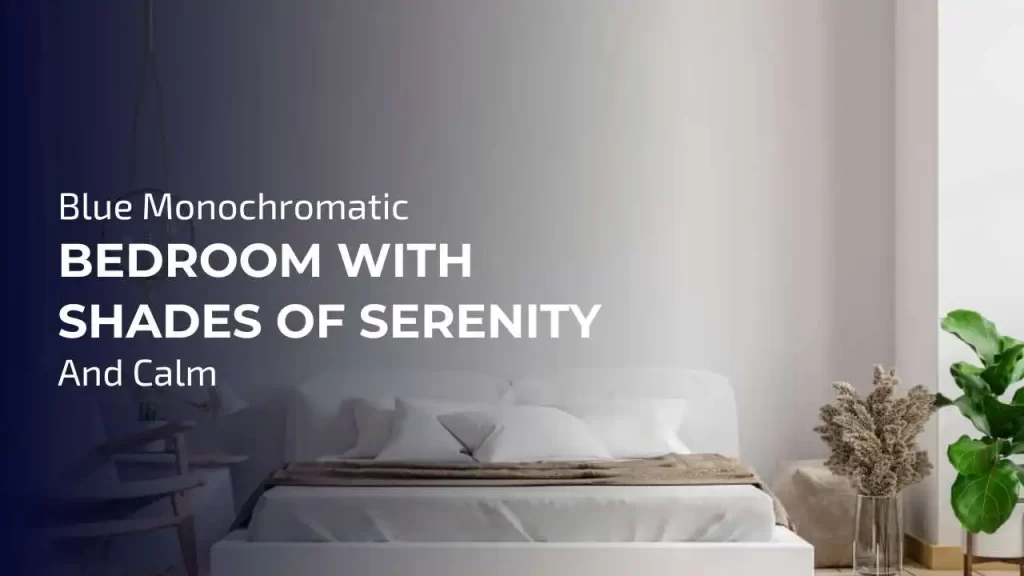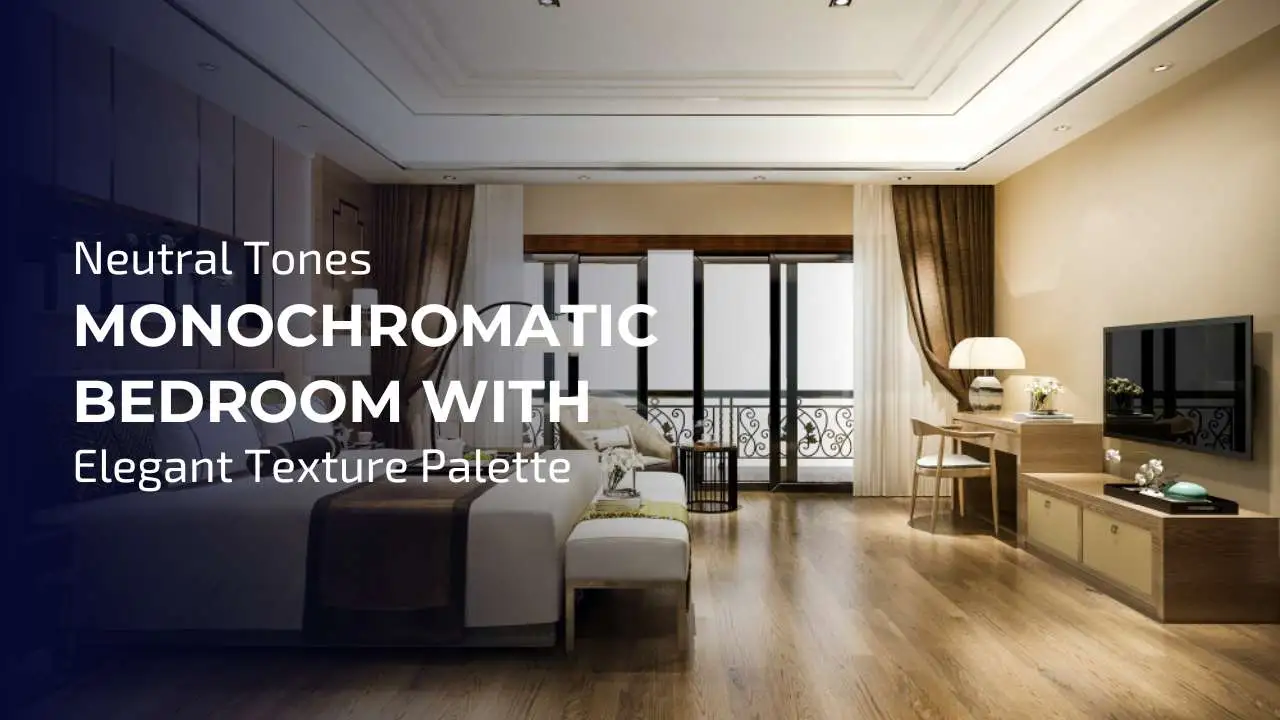A monochromatic bedroom is a classic choice for those who appreciate simplicity and elegance. The concept of a monochromatic color scheme involves using different shades, tints, and tones of one color throughout the room, creating a cohesive and soothing aesthetic. While it may sound limiting, this approach offers endless possibilities for personalization and style. However, achieving a balanced and stylish monochromatic bedroom requires careful thought to ensure that the space doesn’t feel dull or flat. Let’s explore how to create a monochromatic bedroom that exudes style, sophistication, and comfort.
1. The Power of a Monochromatic Color Scheme
At the heart of a monochromatic bedroom is the color scheme. Choosing one base color and then experimenting with its various shades and tints can bring a serene, harmonious look to your room. The key is to play with different textures and layers of the same color to add depth and dimension to the space. For example, pairing light and dark hues of the same color or incorporating different textures like velvet, linen, and wood can bring sophistication and warmth to the space.

2. Picking the Right Color for Your Monochromatic Bedroom
When choosing the perfect color for your monochromatic bedroom, it’s important to consider the mood you want to create. The color you select will set the tone for the entire room.
Blue Monochromatic Bedroom
Blue is one of the most popular choices for a monochromatic bedroom. It evokes a sense of calm, serenity, and tranquility, making it perfect for a restful space. You can incorporate varying shades of blue, from light powder blue to rich navy, to create a serene ambiance. Add accent pieces like a patterned blue throw or a vibrant piece of artwork to create visual interest.
White
For a clean, fresh look, white is an excellent choice. A white monochromatic bedroom creates a bright, airy atmosphere and makes the room feel larger. To prevent the space from looking sterile or lifeless, you can introduce different textures, such as plush bedding, wooden furniture, or a woven rug. This will add warmth and depth to your all-white sanctuary.

Purple Monochromatic Bedroom
Purple, especially deep plum or lavender, is an elegant and dramatic color choice for a monochromatic bedroom. Dark purple walls paired with lighter purple bedding and accessories create a sophisticated and cozy environment. This color scheme works well in larger bedrooms, where it can provide a rich and opulent feel.
Green

Green is a refreshing and versatile color that can make your monochromatic bedroom feel tranquil and grounded. From soft sage to vibrant emerald, green offers a wide range of shades that work well in a variety of spaces. To add interest and avoid monotony, combine matte and glossy finishes, such as a velvet headboard paired with a silk throw.
Neutral Tones
Neutral tones like beige, tan, and gray create a warm, understated feel in a monochromatic bedroom. A tan monochromatic bedroom can be grounded with a natural texture palette, such as linen curtains, wicker furniture, and a neutral rug. These hues can be balanced with gold, brass, or silver accessories to elevate the room’s style.

3. Mixing Textures and Materials
The key to enhancing your monochromatic bedroom lies in the textures and materials you use. Since the color palette remains consistent, it’s the textures that add the most interest. Experiment with different textures like velvet, linen, wool, and cotton to add richness and variety. For example, a velvet duvet cover can be complemented by a linen bed skirt or throw pillows made from natural fabrics.
Adding Textural Contrast
A monochromatic color scheme can become more dynamic when you incorporate contrasting textures. Mix a plush velvet bedspread with a woven rattan headboard to introduce a sense of depth. A soft wool rug under the bed paired with sleek wooden furniture offers a natural contrast that doesn’t take away from the monochromatic theme but rather enhances it.
4. Accent Pieces to Add Interest
Even within a bedroom, it’s important to incorporate accent pieces that create visual interest. While your color palette remains the same, subtle pops of contrast in the form of accessories can help add character to your space.
Artwork and Mirrors
Artwork and mirrors are essential elements for breaking up the monotony in a monochromatic bedroom. A large mirror can reflect light and make the room feel more expansive. Similarly, a statement piece of art in a complementary shade will add personality and dimension to the walls without overwhelming the space.
Lighting Fixtures
Lighting plays a crucial role in any bedroom, but especially in a monochromatic space. Consider using varied lighting sources, such as a chic chandelier or sconces on the walls. For a cozy feel, add a table lamp with a soft light bulb to create a warm, intimate atmosphere. Don’t forget to use dimmable lights for an adjustable mood throughout the day.
Textiles and Bedding
Incorporating different textiles like throws, pillows, and bedding can help elevate a bedroom. Try adding a contrasting texture to your bedding, such as a knitted throw over a silky duvet, to create a tactile experience. Pillows of various sizes and fabrics can also add visual interest, preventing the space from feeling flat.
5. Creating a Cohesive Theme
To avoid a monochromatic bedroom feeling monotonous, it’s essential to stick to a cohesive theme. Whether it’s modern, rustic, or bohemian, choosing a style to align with your chosen color palette will help tie everything together. For instance, if you opt for a neutral palette, you could create a Scandinavian-inspired space with minimalist furniture and clean lines. If you choose a bold color like purple, you might want to pair it with vintage-inspired or art-deco pieces for a touch of glamour.
6. Lighting and Ambience
Lighting is an essential part of creating the perfect mood in a bedroom. Because the colors of the room are uniform, lighting can be used to highlight certain features or create a more relaxed atmosphere. Soft, warm lighting will help prevent the space from feeling too cold or clinical.
Layering Light
Layering your lighting sources helps you control the intensity of the light, giving your bedroom a versatile and balanced feel. Overhead pendant lights can provide ample light for general illumination, while wall sconces or table lamps offer softer, more intimate lighting for reading or relaxing.
Frequently Asked Questions
A monochromatic bedroom is a space designed using different shades, tints, and tones of a single color. The focus is on creating harmony by keeping the color scheme consistent throughout the room while adding variety through textures, patterns, and accessories.
Yes, you can! Bold colors like navy, plum, or emerald green can create a stunning monochromatic bedroom. The key is to balance the intensity of the color with complementary tones and textures to avoid overwhelming the space.
To avoid a dull monochromatic bedroom, mix different textures, materials, and finishes. Incorporate varying shades of the color, add interesting accent pieces, and use lighting creatively to create depth and interest.
Yes, a monochromatic color scheme can work well in small spaces. Lighter shades of color like white, light gray, or soft pastels can make a room feel larger, while darker tones can create a cozy, intimate atmosphere.
Layered lighting works best in a monochromatic bedroom. Combine overhead lighting, task lighting, and accent lighting to create a warm, inviting atmosphere that highlights the room’s design elements.





